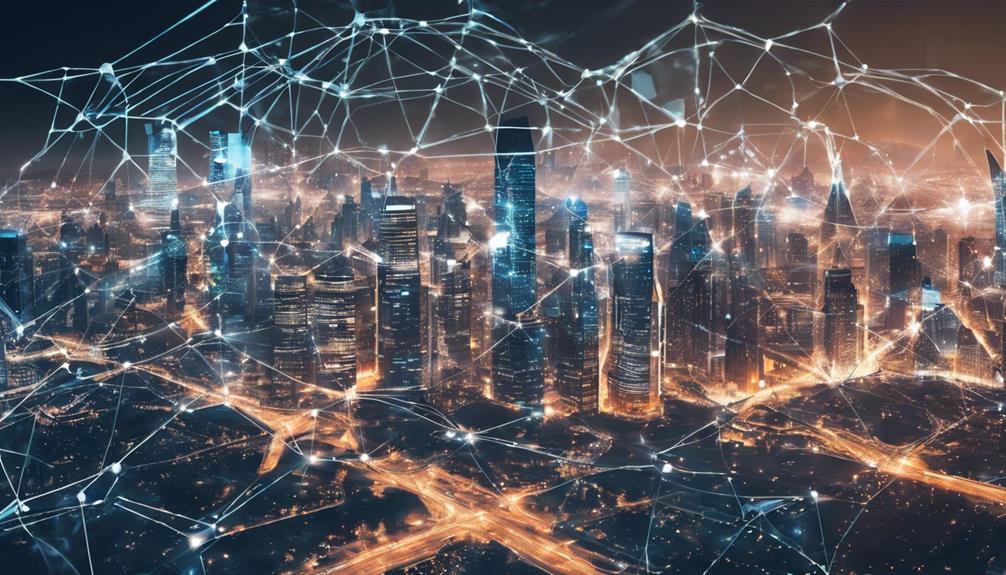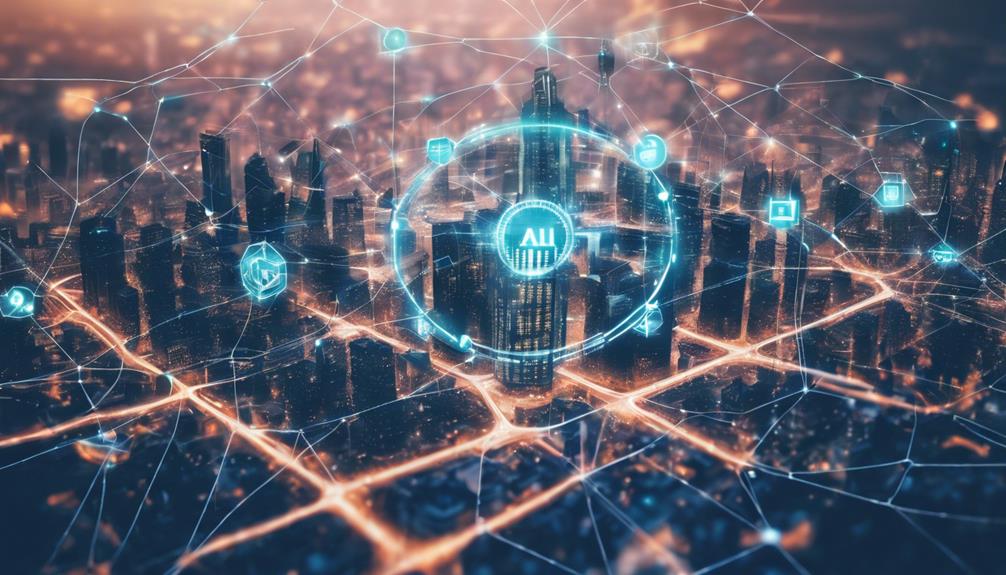In 2023, AI in cyber security advances with cutting-edge techniques. Leveraging Language Models, professionals detect threats efficiently. Integrating Generative AI with traditional tech offers new opportunities. Automating Red Teaming tasks boosts effectiveness. Expanding Attack Surface Security reduces risks effectively. User Approval for LLM Agent Actions guarantees transparency. Regulatory efforts like GDPR safeguard sensitive data. AI enhances detection, aiding in scammers' identification. The essential approach in cybersecurity is vital for safeguarding digital environments effectively. Stay informed to tackle evolving cyber threats and enhance digital security. Further insights await on the horizon for AI and cyber security in 2023.
Key Takeaways
- Leveraging Language Models (LLMs) for enhanced threat detection and response.
- Integrating Generative AI with traditional technologies for innovative security solutions.
- Automating Red Teaming tasks to increase efficiency and effectiveness.
- Expanding Attack Surface Security measures with AI integration.
- User Approval for LLM Agent actions to ensure transparency and accountability.
Leveraging Language Models (LLMs)
The integration of Language Models (LLMs) such as GPT-3 and BERT is pivotal in revolutionizing the field of cybersecurity by bolstering threat detection and response capabilities. By analyzing vast amounts of text data in real-time, LLMs empower cybersecurity professionals to identify patterns, anomalies, and potential security risks more effectively.
This advanced technology enables teams to enhance incident response, automate security tasks, and improve overall security posture.
Integrating LLMs into cybersecurity operations provides a significant advantage in enhancing threat intelligence and vulnerability assessment processes. Leveraging advanced natural language processing techniques, LLMs can detect and mitigate cyber threats with greater accuracy and speed.
As organizations face increasingly sophisticated cyber threats, harnessing the power of LLMs is imperative for staying ahead of malicious actors and safeguarding sensitive data.
Integrating Generative AI With Traditional Technologies

Moreover, Integrating Generative AI with traditional technologies presents a paradigm shift in the cybersecurity landscape, introducing both innovative opportunities and heightened security challenges. The convergence of generative AI with existing systems creates intricate vulnerabilities within consumer products, expanding the attack surface for cyber threats. Developers are tasked with implementing robust security measures to mitigate the risks associated with integrating Language Models (LLMs) into products effectively.
User approval for actions executed by LLM agents emerges as a critical factor in safeguarding the security and integrity of AI-driven systems. Moreover, Red teamers and researchers harness generative AI to develop cutting-edge tools, potentially paving the way for the creation of AI assistants tailored to the needs of cybersecurity specialists.
As this fusion progresses, it becomes imperative for cybersecurity professionals to stay abreast of evolving technologies and proactively address the dynamic challenges posed by the integration of generative AI with traditional frameworks.
Automating Red Teaming Tasks

Exploring red teaming tasks through AI enhances cybersecurity professionals' efficiency and effectiveness. By leveraging AI automation, red teamers can expedite the identification of vulnerabilities and streamline the remediation process. AI assistants utilizing Large Language Models (LLMs) and Machine Learning (ML) provide valuable guidance based on the commands executed during penetration testing, empowering cybersecurity specialists to make informed decisions swiftly.
Additionally, the integration of generative AI in red teaming tasks allows for the development of innovative tools that enhance cybersecurity practices.
This strategic integration of AI technology not only optimizes the red teaming process but also frees up cybersecurity professionals to focus on strategic initiatives and complex threat analysis. By automating routine tasks, AI enables professionals to investigate further into threat landscapes, enhancing overall security posture.
Embracing AI in red teaming signifies a proactive approach to cybersecurity, enabling teams to stay ahead of evolving threats and fortify defenses effectively.
Expanding Attack Surface Security Measures

Enhancing cybersecurity resilience involves fortifying defenses against a broadening array of potential threats. With the expanding attack surface in today's digital landscape, organizations must embrace advanced security measures to safeguard their assets.
Implementing Zero Trust Architecture is pivotal in this effort, as it assumes every asset is a potential risk, effectively reducing the attack surface. Cloud Security advancements also play an essential role in protecting against data breaches and unauthorized access, further enhancing security.
By integrating AI into security protocols, organizations can bolster their threat detection and vulnerability assessment capabilities, enabling proactive measures against potential risks. Continuous verification and access control mechanisms within the Zero Trust Architecture framework help mitigate the evolving risks associated with the expanding attack surface.
Leveraging AI-driven security analytics empowers organizations to anticipate and address potential vulnerabilities effectively, staying one step ahead of threats. Incorporating these cutting-edge technologies and strategies is essential for organizations looking to fortify their security posture and defend against the ever-evolving cyber threats in the expanding attack surface.
User Approval for LLM Agent Actions

User approval plays a pivotal role in governing the actions of Large Language Models (LLMs). By incorporating user control mechanisms, individuals can validate or reject LLM-generated suggestions, fostering transparency and accountability in AI decision-making processes.
This user feedback loop not only refines the AI's behavior but also empowers users to oversee and authorize LLM-generated content, aligning with ethical AI practices.
LLM Agent Authorization
Implementing robust mechanisms for user authorization is essential in ensuring accountability and transparency in the decision-making processes of LLM agents in cybersecurity applications.
User approval for LLM agent actions is a pivotal aspect in governing the behavior of these AI-driven solutions. By establishing clear guidelines and permissions, users can effectively oversee the activities of LLM agents, ensuring that their actions align with cybersecurity objectives.
User authorization involves granting explicit consent for the utilization of data, machine learning algorithms, and cybersecurity tools by LLM agents. This process enhances oversight, allowing users to monitor and approve the actions performed by these intelligent systems.
User consent forms the foundation for user approval mechanisms, enabling individuals to have a say in the operations of LLM agents within cybersecurity applications. By prioritizing user authorization, organizations can enhance security measures, mitigate risks, and foster a culture of accountability within their cybersecurity frameworks.
User Control Mechanisms
Empowering stakeholders with the authority to sanction actions undertaken by Large Language Models (LLMs) functioning as AI agents in cybersecurity is a critical aspect of user control mechanisms. User approval mechanisms serve as a fundamental component in ensuring the intelligence behind AI aligns with organizational security policies and objectives.
By involving users in overseeing and authorizing LLM agent decisions, transparency and accountability in digital security operations are heightened. These user control mechanisms play a pivotal role in mitigating risks associated with autonomous decision-making by AI in combating cyber threats.
Organizations benefit from implementing user approval protocols to maintain privacy and enhance security measures. Through user control mechanisms, the digital landscape gains a layer of human oversight that complements the efficiency of AI technologies, fostering a balanced approach towards safeguarding against cyber threats.
Innovative Detection Technologies for Scammers

Utilizing cutting-edge AI-based detection technologies is essential in combating the evolving tactics employed by scammers in the field of cybersecurity. These innovative tools operate in real-time, leveraging sophisticated machine learning algorithms to analyze patterns associated with fraudulent activities.
AI plays a pivotal role in identifying complex scams like deepfake videos and voice manipulation techniques, helping distinguish between legitimate and malicious activities to protect users effectively. By continuously evolving detection techniques, organizations can stay ahead of scammers and prevent potential security breaches.
The use of AI in cybersecurity not only enhances detection capabilities but also enables quick responses to mitigate risks. Embracing these advanced technologies is crucial in the fight against cyber threats, ensuring a proactive approach to safeguarding digital environments.
Stay informed and proactive to safeguard your systems and data effectively.
Regulatory Efforts Against Cyber Threats

Regulatory efforts against cyber threats are pivotal in establishing a secure digital environment by enforcing guidelines and laws to combat cybercrime. To effectively address these challenges, consider the following:
- Cybersecurity Regulations: Laws like GDPR and HIPAA play an essential role in safeguarding sensitive data and upholding cybersecurity standards in various sectors.
- Compliance and Accountability: Adhering to cybersecurity regulations guarantees data protection, privacy, and fosters a culture of responsibility in handling sensitive information.
- Regulatory Frameworks: Establishing clear standards for incident response, breach notifications, and data security is crucial to protect organizations and individuals from cyber threats.
- Collaboration for Success: Close cooperation between regulatory bodies and cybersecurity experts is important to stay ahead of evolving threats, promote regulatory compliance, and enhance overall cybersecurity posture.
Frequently Asked Questions
What Is the Future of Cybersecurity in 2023?
The future of cybersecurity in 2023 entails increased reliance on AI for threat detection and response, bolstering security postures with real-time analysis and proactive measures. Organizations will combat evolving cyber threats effectively by embracing AI-driven tools.
What Is the Future of AI in Cybersecurity?
The future of AI in cybersecurity involves continued advancements in threat detection, vulnerability assessment, and automated response capabilities. AI-driven technologies like machine learning algorithms and behavioral analytics will play a pivotal role in enhancing real-time monitoring and access control measures.
What Is the AI Strategy for Cyber Security?
The AI strategy for cybersecurity encompasses leveraging artificial intelligence to fortify defenses, enhance threat detection, and automate responses. This proactive approach integrates real-time monitoring, anomaly detection, and predictive analytics to mitigate risks effectively.
Why AI Is the Key to Cutting Edge Cybersecurity?
AI is the key to cutting-edge cybersecurity due to its ability to enhance threat detection, automate responses, and provide real-time monitoring. By leveraging AI-driven tools like behavioral analytics and anomaly detection, organizations can reduce attack surfaces and strengthen access control measures.
Conclusion
In summary, the integration of cutting-edge AI techniques in cybersecurity is vital for staying ahead of evolving threats. By leveraging language models, automating tasks, and expanding security measures, organizations can better protect against cyber attacks.
Regulatory efforts and innovative detection technologies further enhance security measures. It is essential to continuously adapt and implement these advancements to safeguard sensitive information and maintain a secure digital environment.
Embracing these advancements will be key in ensuring robust cybersecurity for the future.









